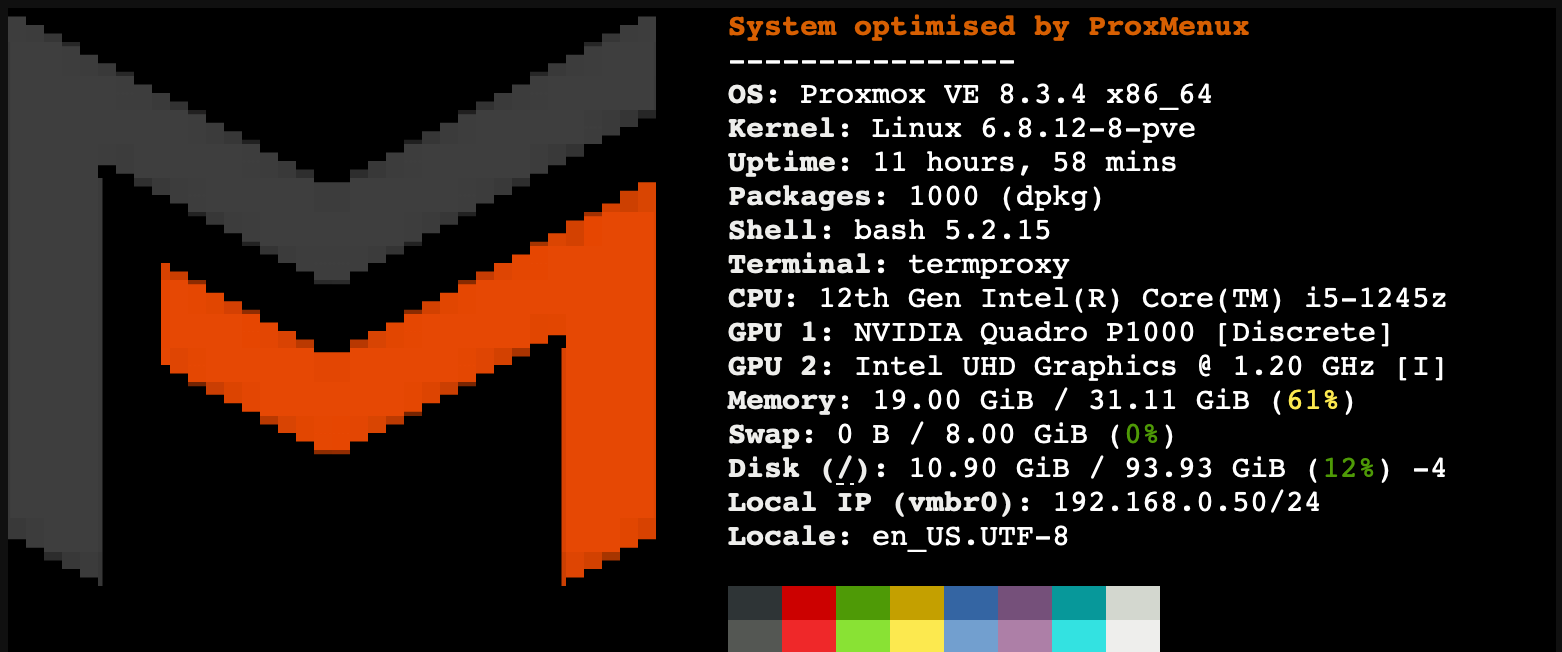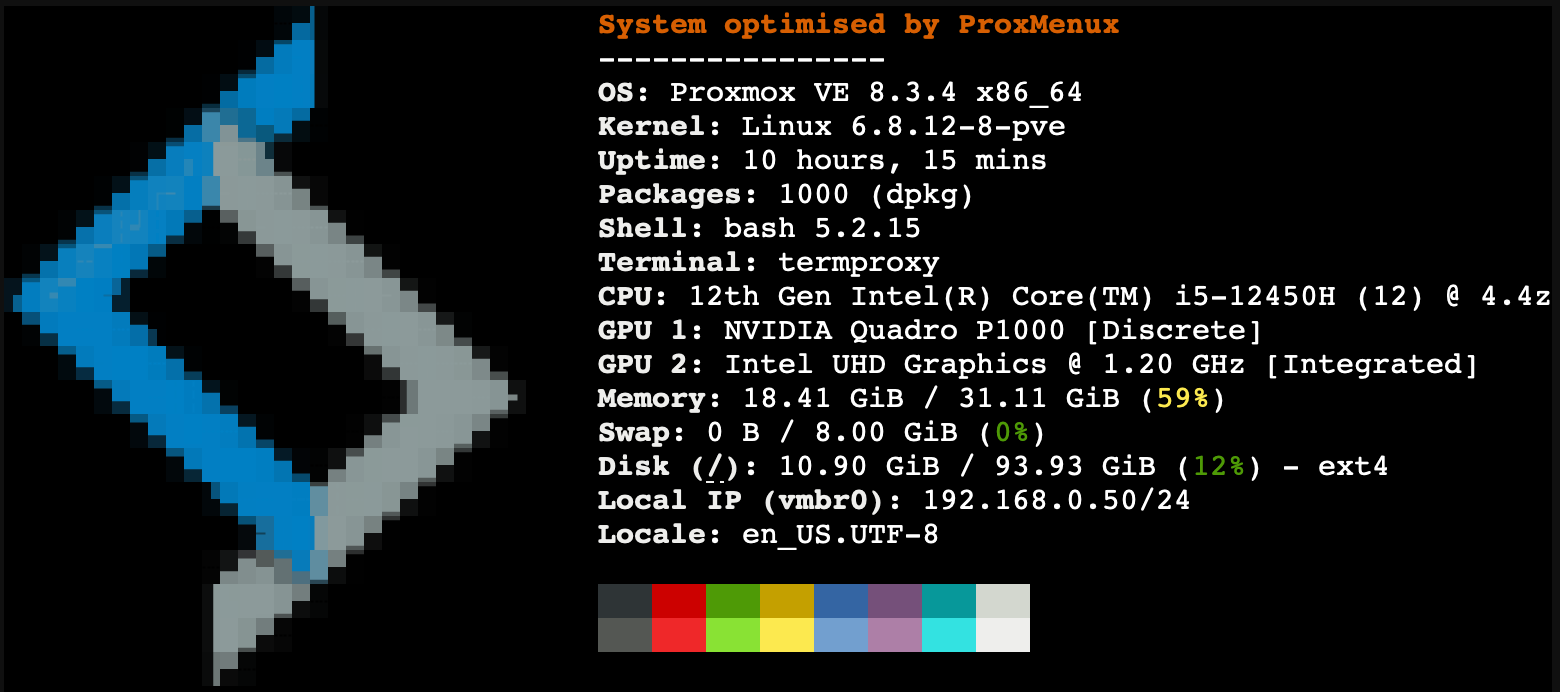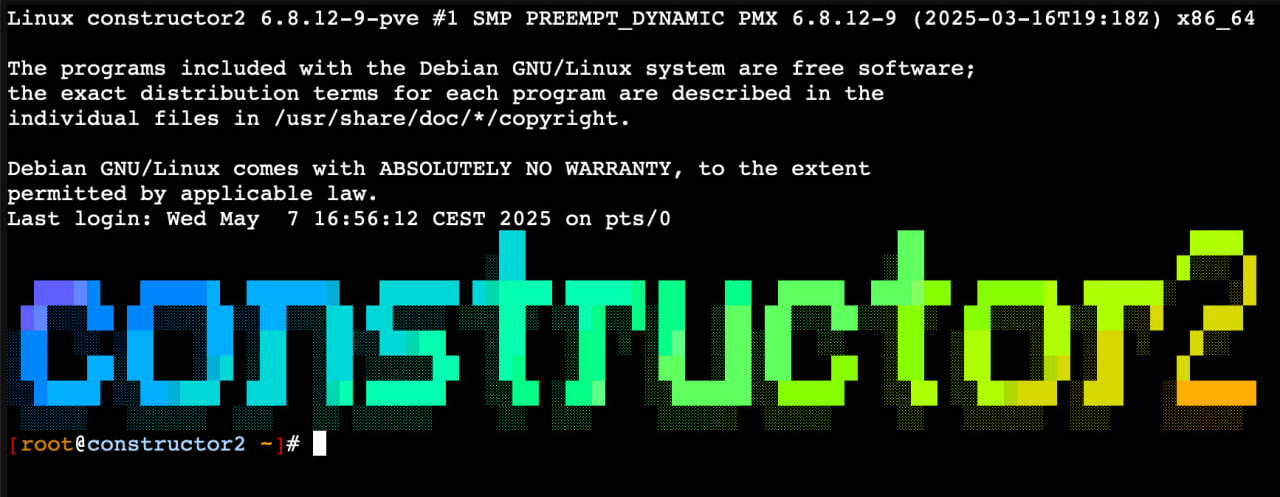Optional Settings
The Optional Settings category provides additional features and optimizations that you can choose to apply to your Proxmox VE installation. These settings are not essential but can enhance your system's capabilities in specific scenarios.
Available Optional Features
1Add Latest Ceph Support
This option installs the latest Ceph storage system support for Proxmox VE. Ceph is a distributed storage system that provides high performance, reliability, and scalability.
What it does:
- Adds the Ceph repository to your system
- Updates package lists
- Installs Ceph packages using the 'pveceph install' command
- Verifies the installation
How to use: After installation, you can configure and manage Ceph storage using the Proxmox VE web interface or command-line tools.
This adjustment automates the following commands:
# Add Ceph repository
echo "deb https://download.proxmox.com/debian/ceph-squid $(lsb_release -cs) no-subscription" > /etc/apt/sources.list.d/ceph-squid.list
# Update package lists
apt-get update
# Install Ceph
pveceph install
# Verify installation
pveceph status
2Apply AMD CPU Fixes
This option applies specific fixes for AMD EPYC and Ryzen CPUs to improve stability and compatibility.
What it does:
- Detects if an AMD EPYC or Ryzen CPU is present
- Applies kernel parameter 'idle=nomwait' to prevent random crashes
- Configures KVM to ignore certain MSRs (Model Specific Registers) for better Windows guest compatibility
- Installs the latest Proxmox VE kernel
How to use: These fixes are applied automatically and require a system reboot to take effect.
This adjustment automates the following commands:
# Set kernel parameter
sed -i 's/GRUB_CMDLINE_LINUX_DEFAULT="/GRUB_CMDLINE_LINUX_DEFAULT="idle=nomwait /g' /etc/default/grub
update-grub
# Configure KVM
echo "options kvm ignore_msrs=Y" >> /etc/modprobe.d/kvm.conf
echo "options kvm report_ignored_msrs=N" >> /etc/modprobe.d/kvm.conf
# Install latest Proxmox VE kernel
apt-get install pve-kernel-$(uname -r | cut -d'-' -f1-2)
3Enable High Availability Services
This option enables High Availability (HA) services in Proxmox VE, allowing for automatic failover of VMs and containers in case of node failure.
What it does:
- Enables and starts the pve-ha-lrm (Local Resource Manager) service
- Enables and starts the pve-ha-crm (Cluster Resource Manager) service
- Enables and starts the corosync service for cluster communication
How to use: After enabling these services, you can configure HA groups and resources in the Proxmox VE web interface.
This adjustment automates the following commands:
systemctl enable --now pve-ha-lrm pve-ha-crm corosync
4Enable Proxmox Testing Repository
This option enables the Proxmox testing repository, allowing access to the latest, potentially unstable versions of Proxmox VE packages.
What it does:
- Adds the Proxmox testing repository to the system's package sources
- Creates a new file in /etc/apt/sources.list.d/ for the testing repository
- Updates the package lists to include packages from the new repository
How to use: After enabling this repository, you can update and upgrade your system to get the latest testing versions of Proxmox VE packages. Use with caution as these versions may be unstable.
To manually add the Proxmox testing repository, you can use these commands:
# Add Proxmox testing repository
echo "deb http://download.proxmox.com/debian/pve $(lsb_release -cs) pvetest" | sudo tee /etc/apt/sources.list.d/pve-testing-repo.list
# Update package lists
sudo apt update
Note: $(lsb_release -cs) automatically detects your Proxmox VE version codename (e.g., bullseye).
Warning: Enabling the testing repository may lead to system instability. It's recommended for testing environments only.
5Install and Configure Fastfetch
This option silently installs and configures Fastfetch, a system information tool that displays system specs and a custom logo at login.
What it does:
- Silently downloads and installs the latest version of Fastfetch
- Allows you to choose a custom logo (ProxMenux, Proxmox, Helper-Scripts, Home-Labs-Club, Proxmology, or a custom one)
- Configures Fastfetch to display "System optimised by ProxMenux"
- Sets up Fastfetch to run automatically at console login
Important:
If you connect to Proxmox via SSH, you should select the Proxmox logo or create a custom one using jp2a or img2txt. The other logos are generated using chafa and may not display correctly in a standard SSH session.
Custom Logos:
To use a custom logo, place your ASCII art text file in: /usr/local/share/fastfetch/logos/
You can create custom logos using tools like chafa, jp2a, or img2txt.
For best results:
- Keep the logo height to 35 lines or less to maintain proportions and fit in the terminal
- Use
chafafor color logos (may not display correctly in SSH sessions) - Use
jp2aorimg2txtfor SSH-compatible logos
Example Logos:
ProxMenux

Proxmox

Helper-Scripts

Home-Labs-Club

Proxmology

This adjustment automates the following commands:
# Download and install the latest version of Fastfetch
FASTFETCH_URL=$(curl -s https://api.github.com/repos/fastfetch-cli/fastfetch/releases/latest | grep "browser_download_url.*fastfetch-linux-amd64.deb" | cut -d '"' -f 4)
wget -q -O /tmp/fastfetch.deb "$FASTFETCH_URL"
dpkg -i /tmp/fastfetch.deb
apt-get install -f -y
# Configure Fastfetch (logo selection remains interactive)
# The configuration is done through a series of jq commands
# Set Fastfetch to run at login
echo "clear && fastfetch" >> ~/.bashrc
6Install and Configure Figurine
This option installs and configures Figurine, a tool that creates stylish ASCII text banners for your terminal, displaying your hostname in a visually appealing 3D format.
What it does:
- Downloads and installs Figurine v1.3.0 from GitHub
- Creates a welcome message that displays your hostname in 3D ASCII art when you log in
- Automatically removes any previous Figurine installation if present
- Sets up the welcome message to run automatically at login
Practical Use:
When managing multiple Proxmox nodes in a cluster, Figurine provides an immediate visual indication of which node you're currently logged into. This helps prevent accidental commands on the wrong node and improves your workflow when managing multiple servers.
Example Output:

This adjustment automates the following process:
# Check for previous installation and remove if found
if command -v figurine &> /dev/null; then
rm -f "/usr/local/bin/figurine"
fi
# Download and install Figurine
version="1.3.0"
file="figurine_linux_amd64_v${version}.tar.gz"
url="https://github.com/arsham/figurine/releases/download/v${version}/${file}"
wget -qO "/tmp/${file}" "${url}"
tar -xf "/tmp/${file}" -C "/tmp"
mv "/tmp/deploy/figurine" "/usr/local/bin/figurine"
chmod +x "/usr/local/bin/figurine"
# Create welcome message script
cat << 'EOF' > "/etc/profile.d/figurine.sh"
/usr/local/bin/figurine -f "3d.flf" $(hostname)
EOF
chmod +x "/etc/profile.d/figurine.sh"
After installation, you'll see your hostname displayed in 3D ASCII art each time you log in, making it immediately clear which Proxmox node you're working on.
Automatic Application
These optional features are applied only when specifically selected during the post-install process. Each feature can be individually chosen based on your specific needs and preferences.